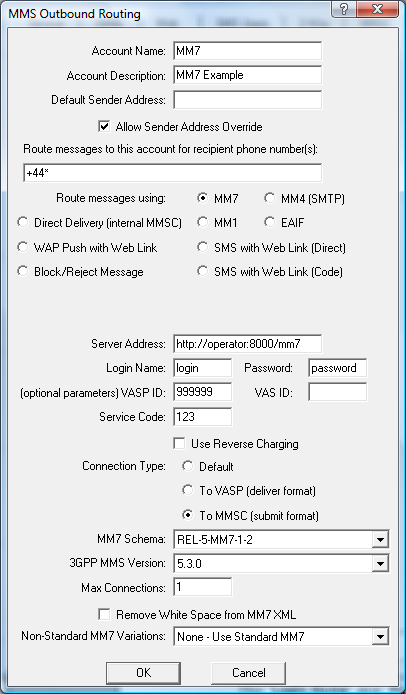Below is shown the configuration for an “MMSC Routing” using an MM7 connection to an operator MMSC (or other MMSC provider):
“Account name” and “Account Description” are settings that identify the connection to the Now SMS & MMS Gateway only. These settings are not transmitted externally.
“Default Sender Address” specifies the default sender address to applied to any MMS messages that are transmitted over this connection. The “Default Sender Address” is used only if the message being transmitted does not include a sender address. This address can either be a standard e-mail address, or a telephone number. If a telephone number is specified, it must be specified in MMS messaging format (+phonenumber/TYPE=PLMN). If “Allow Sender Address Override” is checked, then submitted messages can include their own sender address. If this setting is not checked, the sender address for all messages transmitted via the MMSC connection will be changed to the “Default Sender Address”.
When sending to an operator MMSC over GPRS, the operator MMSC will usually not allow a sender address other than the MSISDN of the sending phone. In these cases, it is usually best to leave the “Sender Address” field blank, and allow the MMSC to assign it automatically. To do this, leave the “Default Sender Address” field blank, and uncheck “Allow Sender Address Override”.
The “Route messages to this account for recipient phone number(s)” field is an address mask for defining which recipient phone numbers should be routed to this account. For example, “+44*” would route all messages for the UK country code (44) to this connection. Multiple address masks can be defined. When multiple address masks are defined, they should be separated by a comma only (,) and no white space characters.
If this field is left blank, no messages will be routed to this connection, except under special circumstances.
For MM7 connections, the “Server Address” field should contain a URL for posting to the MMSC. (The “http://” portion of the address is optional.) For example, http://192.168.1.1:8080/mm7. The “Login Name” and “Password” specify an optional login name and password that will be used to login to the MMSC using HTTP Basic Authentication.
“VASP ID”, “VAS ID” and “Service Code” values are optional parameters that may or may not be required by the MM7 provider. Your provider should indicator whether or not these parameters are required.
Check “Use Reverse Charging” if the recipient is to be charged for messages sent via this connection. (This is not supported by all MMSC providers.)
“Connection Type” should be “To MMSC (submit format)” if you are submitting messages to an operator or provider MMSC. “Connection Type” should be “To VASP (deliver format)” if you are configuring an MM7 connection that delivers message to an application.
“MM7 Schema” controls the MM7 XML Schema that is used when generating MM7 responses. Set this value only if the VASP requires a specific MM7 schema.
“3GPP MMS Version” controls the MMS Version that the MMSC uses when generating MM7 responses. Set this value only if the VASP requires a specific MMS version setting.
“Max Connections” specifies the maximum number of concurrent connections that NowSMS can make to this MMSC simultaneously in order to speed up message submission. (The default is 1.)
“Remove White Space from MM7 XML” – The MMSC normally generates MM7 XML in a user friendly format that includes line breaks. Some applications do not like any white space or line breaks within the MM7 XML, and this setting forces any white space to be removed from the XML.
“Non-Standard MM7 Variations” – This setting enables support for connecting to MMSCs that do not support the MM7 standard. NowSMS supports the non-standard MM7 variations deployed by Ericsson, Materna AnnyWay and LogicaCMG. Additionally, NowSMS supports an HTTP multipart file upload interface which can be useful for integrating with custom PHP scripts. This HTTP multipart file upload interface is described in more detail in Receiving MMS Messages with a PHP Script: HTTP File Upload Post.


